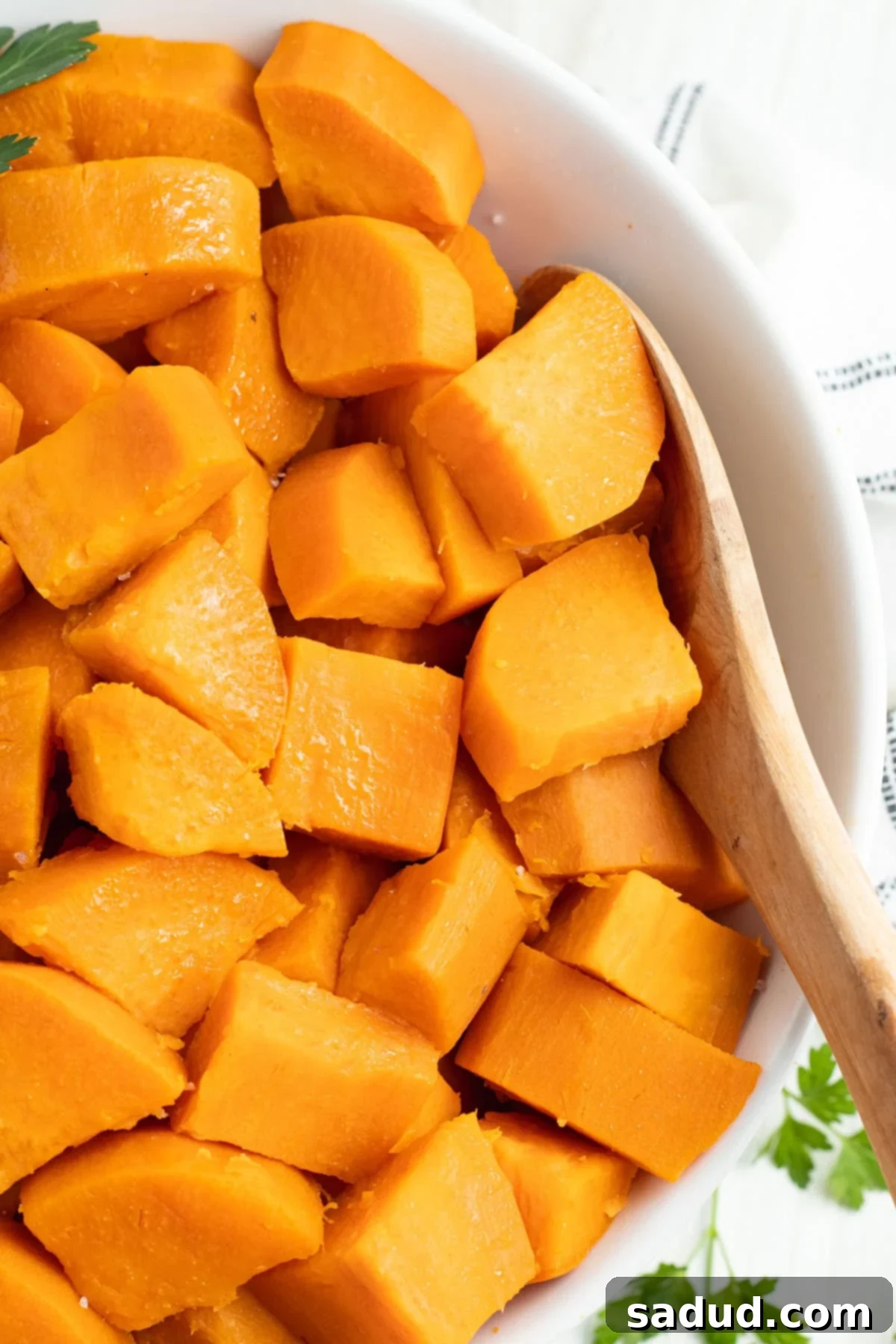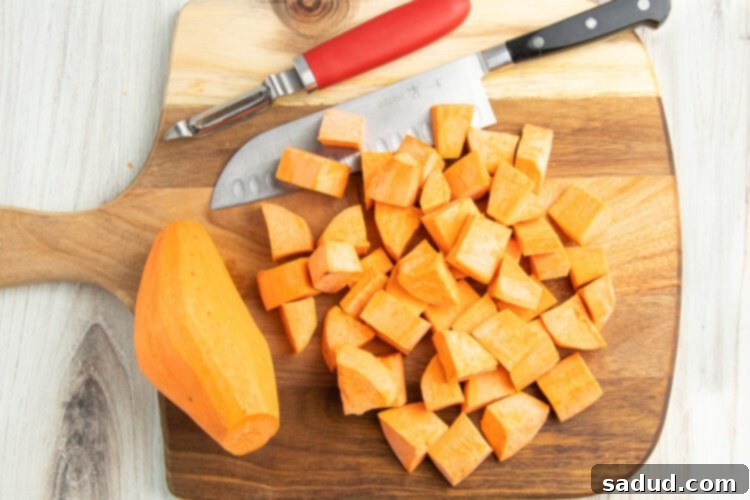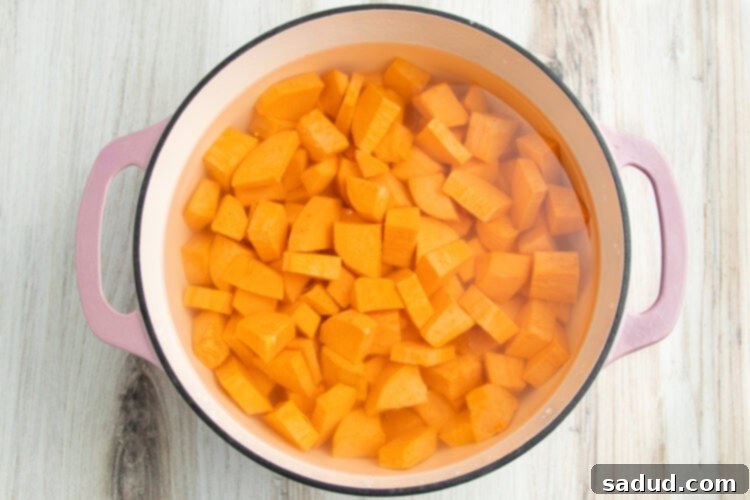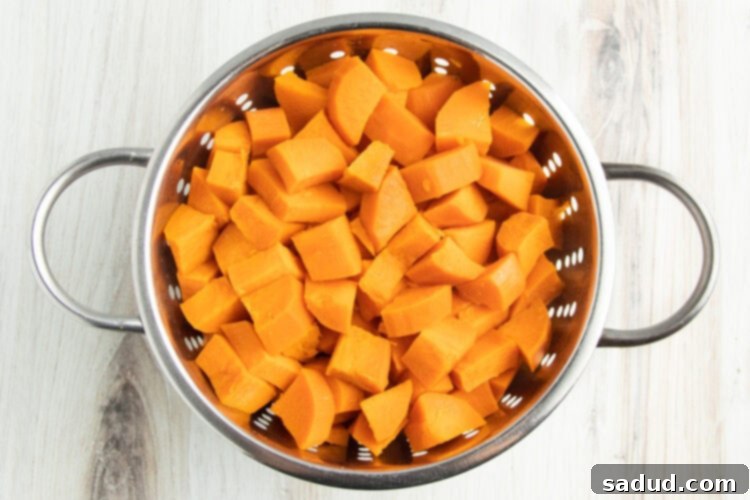How to Perfectly Boil Sweet Potatoes: Your Guide to Quick, Fluffy & Flavorful Results
Learning how to boil sweet potatoes to perfection is a game-changer in the kitchen! This simple yet effective method will equip you with foolproof, perfectly tender sweet potatoes every single time. Whether you’re preparing a creamy sweet potato casserole, whipping up a batch of velvety smooth mashed sweet potatoes, or simply enjoying them as a wholesome side dish, this guide will walk you through each step. Get ready to elevate your cooking with this essential sweet potato technique.
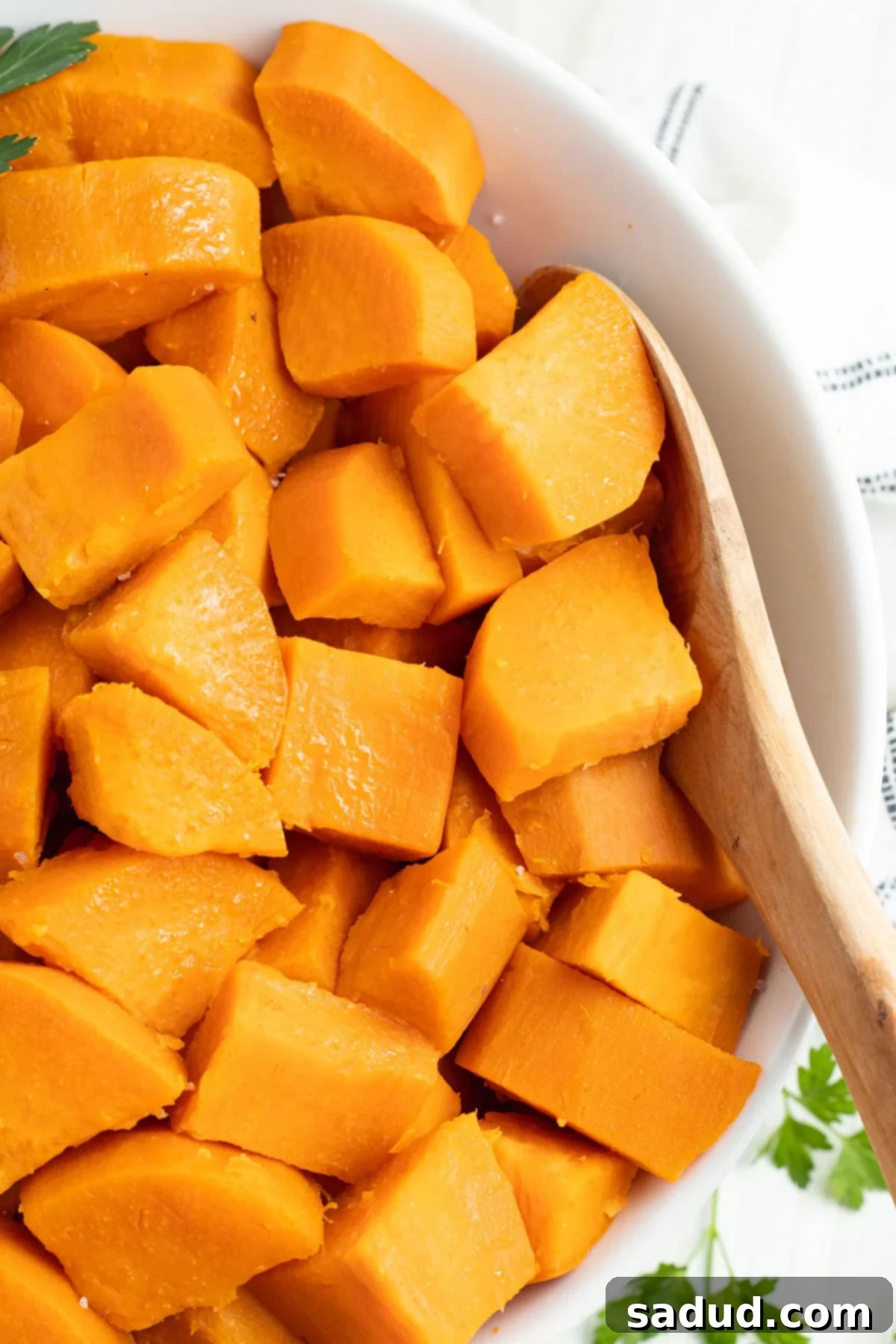
Why Boiling Sweet Potatoes is the Best Method
While there are many ways to cook sweet potatoes, boiling stands out for several compelling reasons, offering both speed and convenience without sacrificing flavor or texture. Discover why this method might just become your new favorite for preparing these versatile root vegetables:
- Unmatched Speed and Efficiency: When time is of the essence, boiling sweet potatoes is superior to other cooking methods like roasting. Roasting, while delicious, can often take upwards of an hour, especially for larger potatoes. Boiling, on the other hand, typically achieves perfectly tender results in just 15-20 minutes. This makes it an ideal option for weeknight dinners or when you need a quick component for a more elaborate meal.
- Effortless Meal Prep Solution: Boiling sweet potatoes makes meal preparation a breeze. You can easily cook a large batch of potatoes at the beginning of the week and have them ready to incorporate into various dishes. Store your cooked sweet potatoes in an airtight container in the refrigerator for up to 5 days, making healthy eating convenient and accessible throughout your busy week. They’re perfect for adding to salads, bowls, or simply reheating as a side.
- Perfect Texture for Blending and Mashing: If your goal is to mash, whip, or blend sweet potatoes into purées for casseroles, soups, or baby food, boiling provides the ideal soft and creamy texture. The gentle cooking in water ensures they become incredibly tender and easy to process, resulting in a smooth, lump-free consistency that’s hard to achieve with other methods.
- Versatile Base for Countless Recipes: Boiled sweet potatoes serve as an excellent foundation for a wide array of recipes. From savory sides like mashed sweet potatoes with herbs and garlic to sweet delights such as sweet potato pie or even quick energy bites, their mild flavor and soft texture adapt beautifully to various culinary applications.
The Incredible Health Benefits of Sweet Potatoes
- Sweet potatoes are celebrated for being a nutritional powerhouse. They are exceptionally high in dietary fiber, which supports digestive health and helps maintain stable blood sugar levels. Furthermore, they are an outstanding source of Vitamin A, crucial for maintaining healthy vision, supporting immune function, and promoting healthy skin. They also provide a significant amount of Vitamin C, a powerful antioxidant that boosts immunity and aids in collagen production. Beyond these, sweet potatoes contain various other vitamins and minerals, along with beneficial antioxidants that help protect your body’s cells from damage. Studies have also indicated their role in promoting a healthy gut microbiome, contributing to overall wellness.
Chef’s Tips for Perfectly Boiled Sweet Potatoes Every Time
Achieving perfectly tender and flavorful boiled sweet potatoes is easy when you follow a few expert guidelines. These tips will help you avoid common pitfalls and ensure your sweet potatoes come out just right, whether you’re mashing them, adding them to a stew, or enjoying them plain.
- To Peel or Not to Peel? The Skin Deep Debate: This is a common question, and the answer truly depends on your preference and the intended use of your sweet potatoes. The skin of a sweet potato is not only edible but also packed with fiber and nutrients, contributing to its overall health benefits. If you’re planning to mash or purée the potatoes for a smooth texture, peeling is usually recommended. However, if you enjoy a more rustic texture or plan to use the cubes in salads or as a simple side, keeping the skin on is perfectly fine and adds an extra layer of nutrition. If you opt to leave the skin on, **it is absolutely crucial to wash and scrub your sweet potatoes thoroughly under running water before cooking.** Since they grow underground, they can carry a significant amount of dirt and soil right into your kitchen. A vegetable brush or a clean dish towel can be very effective for this task.
- The Golden Rule: Uniform Cubes for Even Cooking: Consistency in size is paramount when boiling sweet potatoes. It’s essential that you chop your sweet potatoes into evenly-sized cubes before placing them in the pot. Whether you choose 1-inch, 1.5-inch, or 2-inch cubes, the key is uniformity. If you have unevenly sized pieces, some will cook faster than others, leading to a frustrating mix of mushy, overcooked sweet potatoes and hard, undercooked, dense pieces. Take a few extra minutes to ensure your cuts are consistent, and you’ll be rewarded with perfectly cooked potatoes.
- Don’t Just Watch the Clock: The Fork Test is Your Best Friend: While a general cook time is provided (typically 10-20 minutes), the exact duration can vary based on the size of your cubes, the type of sweet potato, and even the altitude. Relying solely on the timer can lead to over or undercooked results. To truly know if your sweet potatoes are ready, **begin checking their doneness by gently poking them with a fork after they’ve been boiling for about 10 minutes.** If the fork slides easily through the center of a potato cube with minimal resistance, they are perfectly cooked and ready to be drained. If you feel any significant resistance, continue cooking and check again every few minutes.
- The Cold Start Method: Why It Matters for Texture: Unlike pasta or some other vegetables, you should **never add raw potatoes directly into already boiling water.** This method would cause the exterior of the potatoes to cook rapidly, becoming soft and mushy, while the interior struggles to cook through. By the time the centers are fully tender, the outsides would be severely overcooked and possibly disintegrating. Instead, always place your chopped sweet potatoes into a pot with cold water, ensuring they are fully submerged. Then, bring the water to a boil *with* the potatoes in it. This gradual heating allows the sweet potatoes to cook slowly and evenly from the outside in, resulting in a perfectly tender texture throughout without any mushiness.
- Don’t Forget the Salt: Enhancing Flavor from Within: A common mistake when boiling vegetables is forgetting to season the water. Adding a generous pinch of salt (about 1 teaspoon per quart of water) to the cold water before bringing it to a boil will infuse the sweet potatoes with flavor as they cook. This simple step makes a significant difference, preventing bland-tasting potatoes and complementing their natural sweetness. The salt helps to draw out the natural sugars and enhances the overall taste.
- Avoid Overcrowding the Pot: Ensure Even Heat Distribution: While it might be tempting to fit as many sweet potatoes as possible into a single pot, overcrowding can lead to uneven cooking. When the pot is too full, the water temperature can drop significantly, and the potatoes might not circulate freely, leading to some pieces cooking faster or slower than others. Use a pot large enough to comfortably hold your sweet potatoes with enough water to cover them by at least an inch, allowing ample space for the water to boil efficiently and cook the potatoes uniformly.
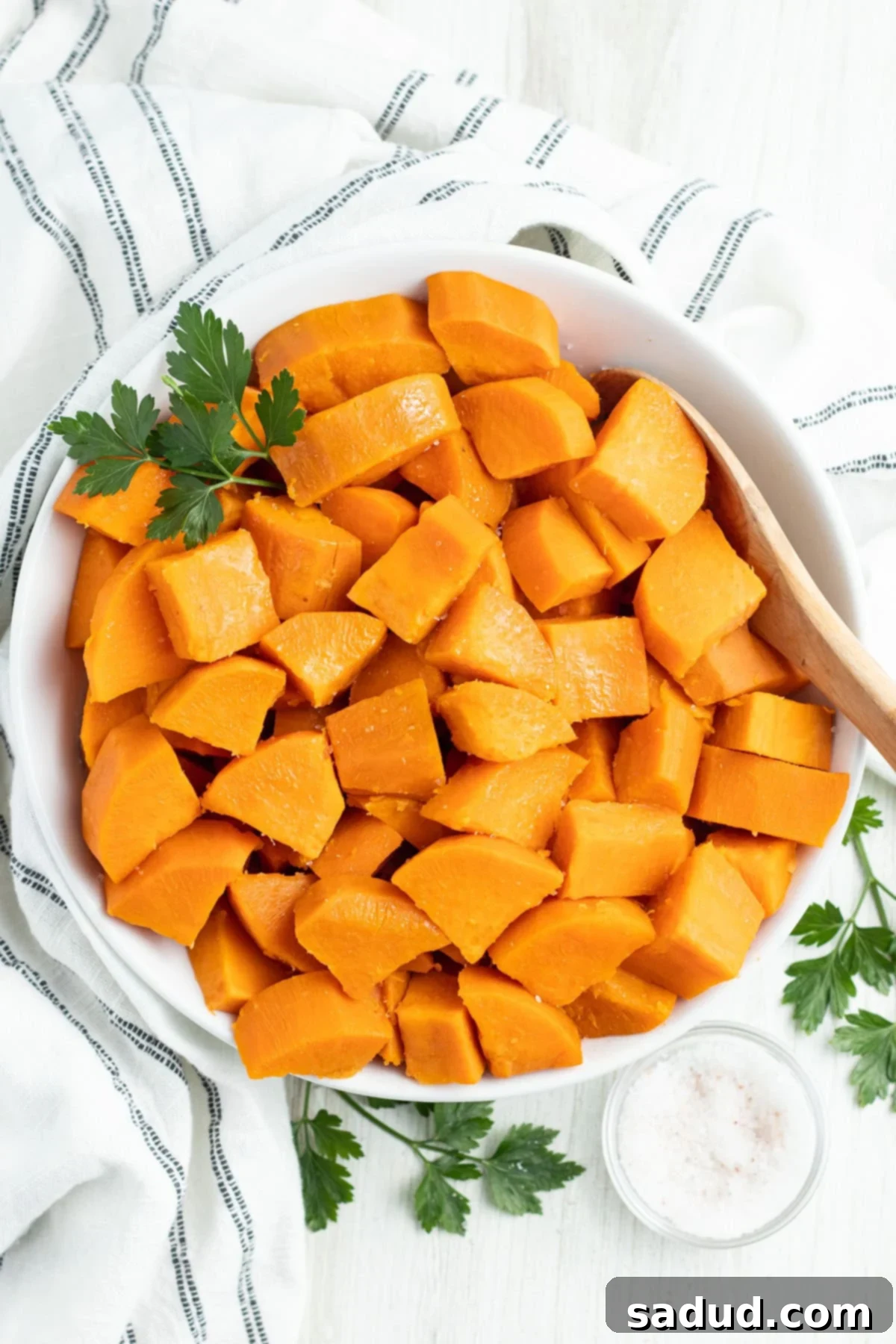
Creative Ways to Use Your Boiled Sweet Potatoes
Once you’ve mastered the art of boiling sweet potatoes, a world of culinary possibilities opens up. Their tender texture and naturally sweet flavor make them incredibly versatile for both sweet and savory applications. Here are some of our favorite ways to incorporate perfectly boiled sweet potatoes into your meals:
- Creamy Scalloped Sweet Potatoes: Transform your boiled sweet potatoes into a decadent side dish by layering them with a rich, creamy sauce and baking until golden.
- Whipped Sweet Potatoes: Mash them with a touch of butter, cream, and seasonings for a light, airy, and incredibly delicious side that’s perfect for holidays or any family meal.
- Sweet Potato Pudding: Create a comforting and flavorful dessert by blending boiled sweet potatoes with spices, milk, and sweeteners, then baking until set.
- Frozen Sweet Potato Fries in the Air Fryer: While this recipe uses frozen fries, understanding boiling sweet potatoes can inspire you to par-boil your own, then season and air-fry them for a healthier homemade version.
- Sweet Potato Rice: A unique and healthy alternative to traditional rice, made by grating or finely dicing boiled sweet potatoes.
- Crockpot Sweet Potatoes: While this specific recipe is for slow-cooked potatoes, your boiled sweet potatoes can be added to the crockpot towards the end of cooking for a quick and tender addition to stews or curries.
- Simple Mashed Sweet Potatoes: A classic for a reason! Just mash with a fork, add a knob of butter, a splash of milk (or plant-based alternative), and a pinch of salt and pepper.
- Sweet Potato Puree for Soups: Blend boiled sweet potatoes into a smooth puree and use it as a base or thickener for creamy vegetable soups.
- Healthy Smoothies: Add a few chilled boiled sweet potato cubes to your morning smoothie for added creaminess, fiber, and nutrients. They pair well with cinnamon, banana, and protein powder.
- Baby Food: Boiled and mashed sweet potatoes are a fantastic first food for babies due to their naturally sweet flavor and smooth texture.
- Sweet Potato Salad: Combine cooled boiled sweet potato cubes with a light vinaigrette, fresh herbs, and other vegetables for a vibrant and healthy salad.
If you loved this simple and effective method for boiling sweet potatoes, don’t forget to leave us a review below! Your feedback helps us grow. ★ And be sure to Follow Easy Healthy Recipes on Pinterest, Facebook, and Instagram for more delicious and healthy ideas!
For more delightful and wholesome recipes, we invite you to explore our sister sites, 40 Aprons and Easy Cheap Recipes.
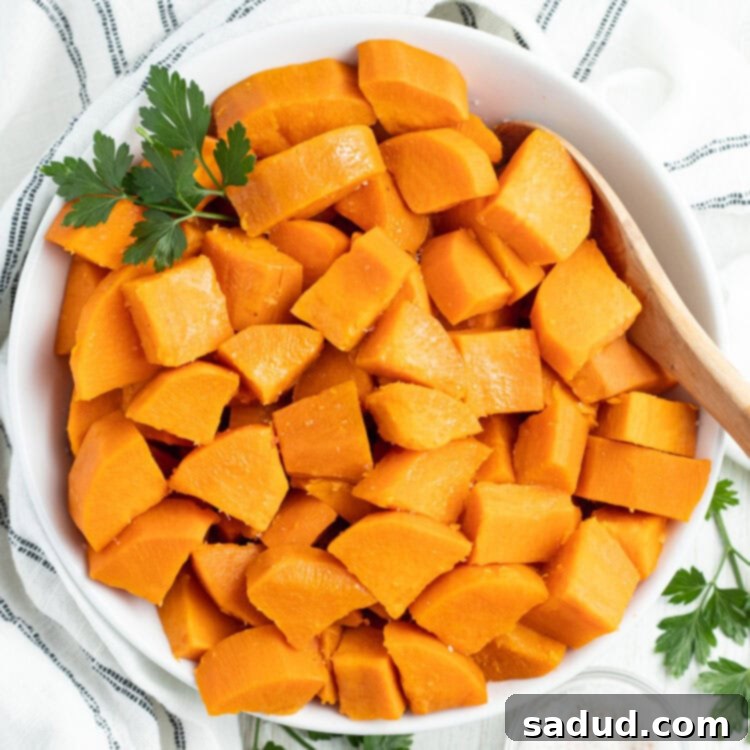
How To Boil Sweet Potatoes Perfectly
 Cheryl Malik
Cheryl Malik
Print
SaveSaved!
Ingredients
- 3 pounds sweet potatoes washed thoroughly, optionally peeled, and uniformly cubed
- cold water enough to completely cover the potatoes by 1 inch
- 1 big pinch salt (about 1 tsp per quart of water, for seasoning)
Equipment
-
Vegetable scrub brush or dish towel for cleaning, optional but recommended
-
Cutting board
-
Potato peeler if peeling your sweet potatoes
-
Sharp knife for even cubing
-
Large pot big enough to hold potatoes comfortably, no lid needed
-
Fork for checking doneness
-
Colander for draining
Instructions
-
Begin by thoroughly scrubbing your sweet potatoes under cold running water, using a vegetable brush or a clean dish towel to remove any dirt or debris. If desired, carefully peel the sweet potatoes. Next, place them on a cutting board and chop them into small, evenly-sized cubes (e.g., 1-inch pieces) to ensure consistent cooking.

-
Transfer the uniformly cubed sweet potatoes into a large pot. Fill the pot with enough cold water so that the waterline rests about 1 inch above the top of the potatoes. Add a generous pinch of salt to the water to season the potatoes as they cook.

-
Place the pot over medium-high heat and bring the water to a rolling boil. As soon as the water begins to boil vigorously, immediately reduce the heat to medium. Allow the potatoes to simmer, uncovered, for 10 to 20 minutes. Start checking for doneness around the 10-minute mark by gently piercing a potato cube with the tines of a fork. The potatoes are ready when the fork slides easily through the center without much resistance.
-
Once the sweet potatoes are tender to your liking, carefully remove the pot from the heat. Pour the water and potatoes into a colander in the sink to drain thoroughly. Allow any excess steam to escape for a minute. Your perfectly boiled sweet potatoes are now ready to be used as desired in your favorite recipes!

Notes
- Safety Tip for Draining: If your pot is too full or heavy for you to comfortably and safely pour the hot water and potatoes into a colander, you can opt to use a large slotted spoon or spider strainer to carefully remove the cooked potatoes from the pot instead.
- Cook Time Variation: The total cooking time will vary depending on the size of the sweet potato cubes you cut. Smaller cubes will naturally cook faster than larger ones. The key is to keep all your cubes as even as possible to ensure uniform cooking and consistent texture.
- Storage: Allow any leftover boiled sweet potatoes to cool completely. Store them in an airtight container in the refrigerator for up to 5 days. They can be reheated gently on the stovetop, in the microwave, or enjoyed cold.
Nutrition Information
The number of total servings shown is an approximation. The actual number of servings will depend on your preferred portion sizes and the size of your sweet potatoes.
Nutritional values shown are general guidelines and reflect information for 1 serving using the ingredients listed, not including any optional ingredients. Actual macros may vary slightly depending on specific brands and types of ingredients used. This information is provided as a courtesy and should not be considered a substitute for professional nutritional advice.
To accurately determine the weight of one serving for your specific batch, prepare the recipe as instructed. Weigh the entire finished recipe (excluding the weight of the container). Then, divide the total weight by your desired number of servings to get the precise weight of one serving.
Storage and Reheating Tips for Boiled Sweet Potatoes
Once you’ve perfectly boiled your sweet potatoes, proper storage ensures they stay fresh and delicious for future use. Here’s how to store and reheat them:
- Cool Completely: Before storing, allow the boiled sweet potatoes to cool down to room temperature. This prevents condensation inside the container, which can lead to sogginess and faster spoilage.
- Airtight Container: Transfer the cooled sweet potato cubes or mash into an airtight container. This protects them from air exposure and prevents them from drying out or absorbing refrigerator odors.
- Refrigeration: Store the sealed container in the refrigerator for up to 5 days. They are a fantastic ingredient for quick meals throughout the week.
- Freezing for Longer Storage: For longer storage, you can freeze boiled sweet potatoes. Spread cooled cubes in a single layer on a baking sheet and freeze until solid (about 1-2 hours). Once frozen, transfer them to a freezer-safe bag or container. They can be stored for up to 3 months. For mashed sweet potatoes, portion them into freezer-safe bags or containers.
How to Reheat Boiled Sweet Potatoes:
- Microwave: For quick reheating, place desired amount in a microwave-safe dish. Add a tablespoon of water or broth, cover, and microwave on high in 30-60 second intervals, stirring occasionally, until heated through.
- Stovetop: For cubes, gently sauté them in a pan with a little butter or oil until warmed. For mashed, add a splash of milk or broth and heat gently over low heat, stirring constantly, until hot.
- Oven: If you’re reheating a larger batch or want a slightly caramelized exterior, spread the cubes on a baking sheet and bake at 375°F (190°C) for 10-15 minutes, or until heated through.
Troubleshooting Common Boiled Sweet Potato Problems
Even with the best intentions, sometimes things don’t go exactly as planned. Here are some common issues you might encounter when boiling sweet potatoes and how to fix or prevent them:
- Mushy Sweet Potatoes: If your sweet potatoes turn out overly soft or mushy, it’s usually a sign of overcooking. This can happen if they are boiled for too long or if the cubes were cut too small. To prevent this, always start checking doneness with a fork at the lower end of the recommended cooking time (around 10 minutes) and remove them from the heat as soon as they are tender-crisp. Cutting uniformly sized cubes also helps. If they’re already mushy, they’re still great for mashing, puréeing into soups, or adding to baked goods!
- Hard or Under-cooked Sweet Potatoes: If your sweet potatoes are still firm or crunchy in the middle after the suggested cooking time, they are under-cooked. This can occur if the heat was too low, the cubes were too large, or if you didn’t start them in cold water (which can lead to uneven cooking). To fix this, simply return them to the pot with hot water and continue simmering until they reach the desired tenderness. Ensure your heat is consistent and that your cubes are uniform in size for next time.
- Bland Flavor: If your boiled sweet potatoes taste a bit flat, you likely forgot to add salt to the cooking water. Salt is crucial for enhancing the natural sweetness and overall flavor. While you can’t add salt to the cooking water once they’re done, you can always season them generously with salt, pepper, and your favorite spices (like cinnamon, nutmeg, garlic powder, or smoked paprika) after draining. A pat of butter or a drizzle of olive oil also works wonders.
- Unevenly Cooked Potatoes: This almost always points to unevenly sized sweet potato cubes. Some pieces will cook faster than others, resulting in a mix of textures. To avoid this, take extra care to cut all your sweet potato pieces into roughly the same size and shape before boiling. This ensures they all cook at the same rate.
By understanding these common issues and how to address them, you’ll be well on your way to boiling perfect sweet potatoes every time!
Mastering the art of boiling sweet potatoes is a foundational skill that will serve you well in the kitchen. It’s a method that promises speed, simplicity, and consistently delicious results, making it ideal for everything from quick weeknight dinners to elaborate holiday feasts. By following our easy step-by-step guide and chef’s tips, you can confidently prepare sweet potatoes that are perfectly tender, full of flavor, and ready to be transformed into your favorite dishes. Enjoy the versatility and nutritional benefits of these incredible root vegetables with this foolproof boiling technique!
